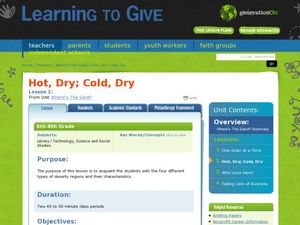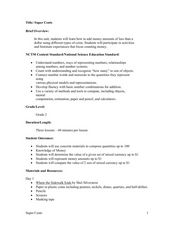Curated OER
Germ Busters
Young scholars discuss importance of cleanliness, specifically hand-washing, in fighting germs and illness. They create cultures of their hands before washing, and then practice proper hand-washing technique.
Curated OER
Where's the Sand?
Students identify the characteristics of deserts. In this geography lesson plan, students discuss the characteristics of a desert and label a map with the names of deserts.
Curated OER
Create a Cloud in a Bottle
Students examine the earth's atmosphere. In this hands-on science lesson, students follow the outlined steps to create clouds in 2-liter bottles.
Curated OER
Super Cents
Second graders study money amounts less than a dollar. In this math instructional activity, 2nd graders practice counting coins. Students read various stories and discuss how money was used in the stories.
Curated OER
Echo Location
Students participate in a role-playing activity that demonstrates how whales use sound as an adaptation to their environment.
Curated OER
Investigation 7 - Rubbing Objects Together
Third graders investigate rubbing two objects together to produce heat.
Curated OER
Stories That Grow on Trees
Students create their own plot-choice story after reading and discussing a commercially published plot-choice book.
Curated OER
Old Fashioned Christmas Toy
Students create an old fashioned toy that explains stored, potential and movement energy.
Curated OER
Library Media
Fifth graders find or shelve books in the library. In this library books lesson, 5th graders find books and learn how to shelve books in the library.
Curated OER
Goofy Putty
Students examine mixtures and solution properties by making a borax polymer. In this chemical reactions lesson, students make a putty out of borax solution mixed to create a polymer.
EL Education
El Education: The Crusades
Students research the math and physics behind various weapons used during the crusades to write an illustrate articles to add to a class book.
Utah Education Network
Uen: Recognizing Chemical Reactions
Students will add 4 chemicals to a beaker and observe the changes that take place. They will classify them as physical or chemical changes.













